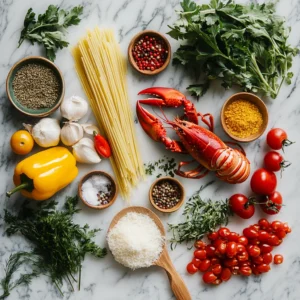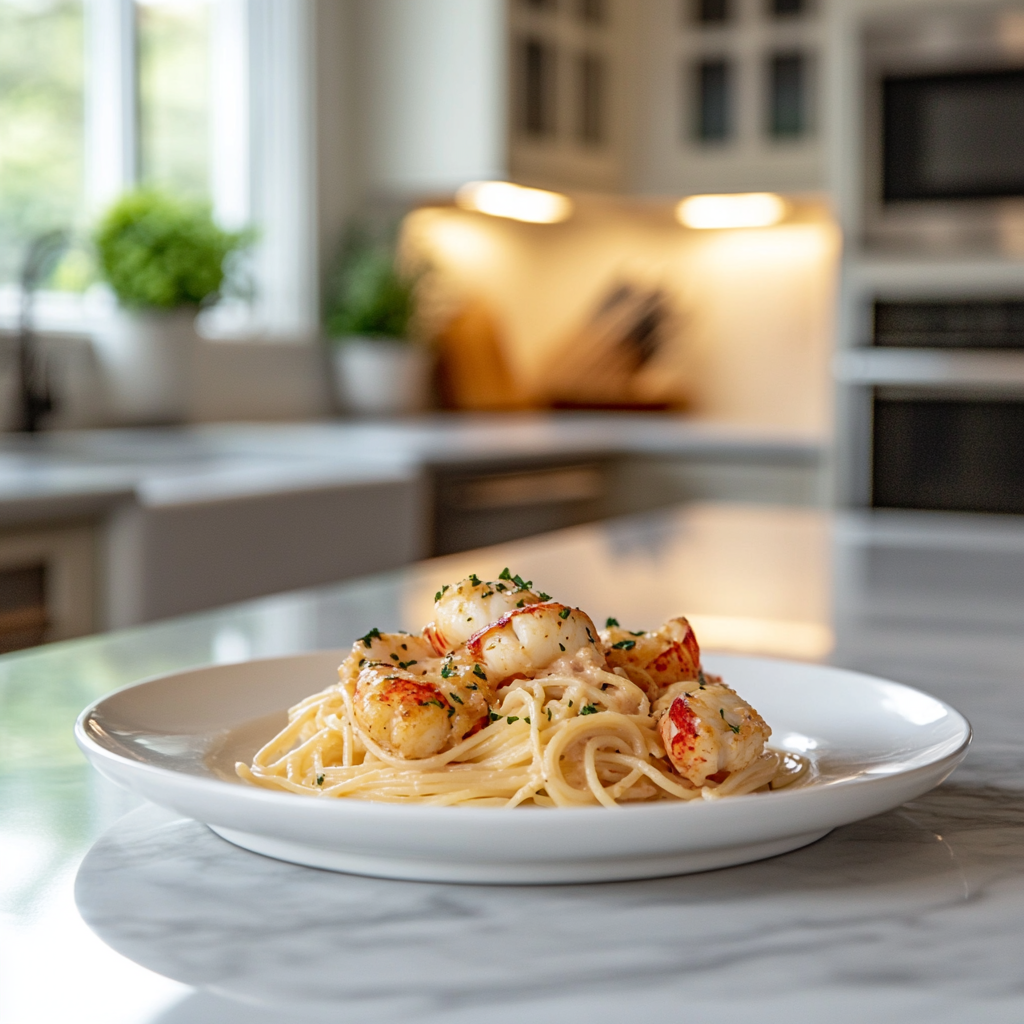Discover the art of creating an exquisite lobster pasta dish that marries the sweet, succulent flavors of fresh lobster with perfectly cooked pasta and a rich, creamy sauce.
This comprehensive guide will walk you through every step, from choosing the finest ingredients and preparing the lobster to creating a luscious sauce and plating your masterpiece elegantly. Whether you’re a seasoned chef or an enthusiastic home cook, this article will inspire you to craft a restaurant-quality dish in your own kitchen.
Introduction
The allure of a well-prepared lobster pasta lies in its luxurious blend of flavors and textures. Imagine tender lobster meat combined with al dente pasta, all bathed in a velvety sauce enriched with tomatoes, cream, and fragrant herbs. This dish is perfect for special occasions or when you simply want to treat yourself to a gourmet meal.
- Key Benefits:
- Fresh Lobster: Provides a delicate, sweet flavor that elevates the dish.
- Perfect Pasta: Cooked to al dente perfection, ensuring an ideal bite.
- Decadent Sauce: Combines tomatoes, cream, and fresh herbs for a balanced, savory taste.
History and Background
The lobster pasta dish draws on centuries of culinary tradition in Mediterranean cuisine, where seafood and pasta have long been celebrated together. Lobster, once a humble ingredient, has evolved into a symbol of luxury and sophistication in modern gastronomy. By combining time-honored techniques with contemporary flair, this recipe offers a perfect balance of tradition and innovation.
- Historical Highlights:
- Originating from coastal regions where seafood was plentiful.
- Evolved from simple preparations into a refined dish served in high-end restaurants.
- Continues to inspire chefs worldwide to blend classic and modern culinary methods.
Essential Ingredients and Equipment

The success of your lobster pasta dish depends on using top-quality ingredients and the right kitchen tools. Below is a detailed list of what you will need.
Ingredients
- Fresh Lobster:
- 1 or 2 whole lobsters (preferably live for maximum freshness).
- Tip: Purchase your lobster from a trusted seafood supplier to ensure premium quality.
- Pasta:
- Linguine or fettuccine are recommended, as they hold the sauce beautifully.
- Consider using artisanal pasta for an extra layer of texture and flavor.
- Vegetables and Aromatics:
- Garlic, diced tomatoes, and onions form the base of the sauce.
- Herbs: Fresh basil, parsley, and a hint of thyme to brighten the dish.
- Liquids:
- White wine to deglaze the pan and add depth.
- Heavy cream for a smooth, rich texture.
- Lobster stock (made from the lobster shells) to intensify the seafood flavor.
- Seasonings:
- Salt, black pepper, and a dash of paprika for a subtle smoky note.
Equipment
- Basic Tools:
- A large pot for boiling the pasta.
- A deep skillet or sauté pan for preparing the sauce.
- Sharp knives and a sturdy cutting board for handling the lobster.
- Specialized Items:
- A cooking thermometer to ensure the lobster is perfectly cooked.
- Tongs or seafood-specific tools to handle the lobster safely.
For a precise and safe knife cut, refer to How to Sharpen a Knife: A Comprehensive Guide.
Preparing and Cooking the Lobster
The preparation of the lobster is a crucial step that significantly impacts the final flavor and texture of your dish.
1. Pre-Cooking the Lobster
- Initial Steps:
- Bring a large pot of salted water to a vigorous boil.
- Carefully lower the live lobster into the water and cook for 8 to 10 minutes (depending on size).
- Observation: The lobster’s shell will change from bluish to a vibrant red as it cooks.
- Extraction:
- Remove the lobster from the water and allow it to cool slightly.
- Using a sharp knife, separate the tail and claws, then carefully extract the tender meat.
- Save the cooking water and shells to prepare a flavorful lobster stock later.
- Tips for Success:
- Wear heat-resistant gloves to avoid burns.
- Keep the lobster meat refrigerated until you’re ready to combine it with the sauce.
Cooking the Pasta
Perfectly cooked pasta is the backbone of any great lobster pasta dish. Follow these steps for ideal results.
2. Preparing the Pasta
- Boiling:
- Fill a large pot with water, add a generous pinch of salt, and bring to a rolling boil.
- Add your chosen pasta and cook according to the package instructions until al dente.
- After Cooking:
- Drain the pasta and toss it with a drizzle of olive oil to prevent sticking.
- Hint: Reserve a small cup of pasta water to adjust the consistency of your sauce later if needed.
- Quick Tips:
- Stir frequently during cooking to avoid clumping.
- For creative ideas on reusing extra pasta, visit Leftover Pasta Recipes: Ways to Use Extra Pasta.
Crafting the Perfect Sauce
The sauce is the heart of your lobster pasta dish, binding together the delicate flavors of the lobster and pasta.
3. Building the Sauce
- Aromatic Base:
- In a deep skillet, heat olive oil and sauté minced garlic and chopped onions until they become translucent.
- Add diced tomatoes and allow them to simmer until they break down into a thick, flavorful base.
- Incorporating Liquids:
- Deglaze the pan by pouring in white wine, stirring to lift all the flavorful bits off the bottom.
- Stir in heavy cream and let the mixture simmer, thickening into a luscious sauce.
- Pour in the reserved lobster stock to deepen the seafood flavor.
- Enhancing with Herbs:
- Fold in fresh basil and parsley, and adjust the seasoning with salt, pepper, and a dash of paprika.
- Continue to simmer until the sauce reaches your desired consistency.
- Key Points for a Rich Sauce:
- Tomatoes: Provide acidity and balance the cream.
- Cream: Lends a smooth, velvety texture.
- Wine: Adds a subtle, sophisticated tang.
Combining and Plating
Now that every component is ready, it’s time to assemble your dish into a work of culinary art.
4. Bringing It All Together
- Mixing the Elements:
- Gently fold the lobster meat into the sauce, taking care not to break it apart.
- Add the cooked pasta directly into the skillet and toss thoroughly so that every strand is coated with the sauce.
- Elegant Plating:
- Transfer the pasta onto a wide, shallow serving dish to showcase its vibrant colors.
- Garnish with additional fresh basil, a sprinkle of parsley, and a touch of lemon zest to brighten the flavors.
- Plating Tips:
- Use a large serving spoon to create elegant nests of pasta.
- Drizzle a bit of extra virgin olive oil over the top for a glossy finish.
Variations and Chef’s Tips

Feel free to personalize your lobster pasta recipe by experimenting with various ingredients and techniques. Here are some ideas to spark your creativity:
Customizing Your Dish
- Seasonal Vegetable Additions:
- Incorporate seasonal vegetables such as asparagus or spinach to add color and nutritional value.
- Adjust the herb mix by including seasonal favorites like dill or tarragon.
- Ingredient Substitutions:
- Swap lobster for shrimp or scallops if desired, though the unique flavor of lobster is hard to replace.
- For a lighter version, try a tomato-based sauce without the heavy cream.
- Advanced Techniques:
- Prepare the lobster stock in advance by simmering the shells with aromatics for extra depth.
- Roast the tomatoes before adding them to the sauce to create a richer, more concentrated flavor.
- Storage and Leftovers:
- Leftover lobster pasta can be stored in an airtight container for up to two days.
- Reheat gently on the stovetop, adding a splash of water if the sauce has thickened too much.
For more ideas on how to repurpose leftovers creatively, check out Leftover Pasta Recipes: Ways to Use Extra Pasta.
Nutritional Benefits and Sustainability
Not only does lobster pasta offer a luxurious dining experience, but it also comes with several nutritional and environmental benefits.
Nutritional Profile
- Lobster:
- A rich source of high-quality protein and essential minerals such as zinc and selenium.
- Low in fat, making it a healthier choice for seafood enthusiasts.
- Pasta:
- Provides a solid source of energy through complex carbohydrates.
- Using whole-grain varieties can add additional fiber to your meal.
Health and Environmental Benefits
- Balanced Meal:
- Combines lean protein with energy-giving carbohydrates and nutrient-rich vegetables.
- Perfect for a well-rounded, satisfying meal.
- Sustainable Practices:
- Choosing responsibly sourced seafood helps protect marine ecosystems.
- For more information on sustainable seafood, visit 10 things to know about seafood
Accompaniments and Complementary Recipes

Enhance your dining experience by pairing your lobster pasta with well-chosen side dishes and complementary recipes.
Perfect Pairings
- Saffron Rice:
- A fragrant and colorful side that balances the richness of the pasta.
- Learn how to prepare it by reading Safran Rice Recipe: A Comprehensive Guide.
- Fresh Salad:
- A crisp tomato-cucumber salad offers a refreshing contrast to the warm, creamy pasta.
- For creative salad ideas, visit our Guide to Tomato Cucumber Salad Recipe.
- Refreshing Beverages:
- Pair your meal with a glass of dry white wine or a non-alcoholic option like a zesty Brazilian lemonade.
- Discover the recipe for Brazilian Lemonade Refreshing Lime Drink.
To explore more sumptuous recipes that complement your seafood dishes, consider our article on Mastering the Fried Chicken Tenders Recipe.
Frequently Asked Questions
How do I cook the lobster for this pasta dish?
- Answer:
Begin by bringing a large pot of salted water to a boil. Gently lower the live lobster into the water and cook for 8 to 10 minutes until the shell turns bright red. Remove the lobster, let it cool slightly, then carefully extract the meat. Save the cooking water and shells to make a rich lobster stock for your sauce.
Can I substitute lobster with other seafood?
- Answer:
Yes, while lobster offers a distinctive flavor, you can substitute it with shrimp or scallops. However, note that the unique texture and taste of lobster truly set this dish apart.
What type of pasta works best with this recipe?
- Answer:
Linguine or fettuccine are ideal choices as they hold the sauce well and complement the delicate nature of lobster meat.
How do I store leftovers of lobster pasta?
- Answer:
Store any leftovers in an airtight container in the refrigerator for up to 2 days. Reheat slowly on the stovetop, adding a little water or extra stock to adjust the sauce consistency if necessary.
Conclusion
Crafting a delectable lobster pasta masterpiece is both an art and a science. By carefully selecting high-quality ingredients, mastering the techniques for cooking lobster and pasta, and creating a perfectly balanced sauce, you can produce a dish that is as visually appealing as it is delicious. This recipe not only celebrates culinary tradition but also incorporates modern twists that make it unique and memorable.
- Final Takeaways:
- Quality Ingredients: The freshness of the lobster and the choice of pasta are key.
- Precision in Technique: Timing is crucial for cooking the lobster, pasta, and sauce to perfection.
- Presentation Matters: An elegant plating elevates the dining experience and impresses your guests.
Embrace the joy of cooking, experiment with different variations, and most importantly, enjoy the process of creating a luxurious meal that celebrates the best of seafood and Italian-inspired cuisine.
In summary, this lobster pasta recipe is more than just a meal, it’s an invitation to explore the fusion of traditional techniques and modern culinary innovation. Whether you’re preparing it for a special celebration or an indulgent dinner at home, this dish promises to deliver exceptional flavor, refined presentation, and a truly memorable dining experience.
Enjoy your cooking adventure, and don’t hesitate to experiment with flavors and techniques to make the dish your own. Happy cooking!

